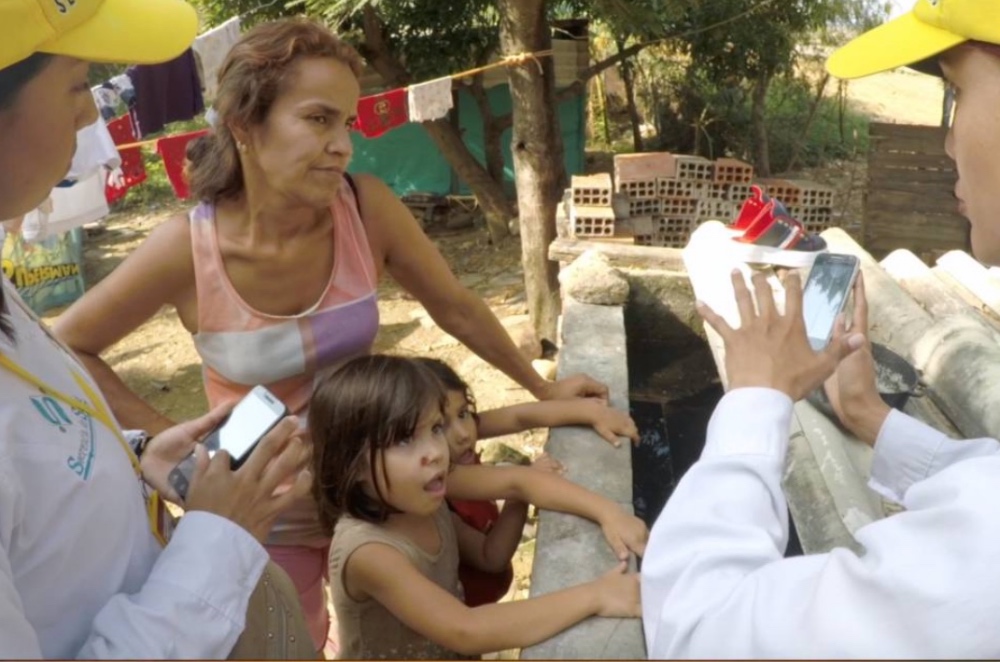Bogota, Colombia
Thomson Reuters Foundation
Armed with a mobile app, Glenis Barragan has been knocking from door to door in the poor neighbourhoods of Colombia’s northern city of Cucuta, aiming to combat the spread of the Zika virus, a mosquito-borne disease.
In the past year, Barragan has helped fellow residents identify and destroy mosquito breeding grounds – from water stored in containers and buckets in homes to puddles of water, rubbish and discarded tyres in city streets and parks.

A house inspection visit in the Colombian city of Cucuta in November, 2018. PICTURE: Courtesy of Premise.
Using a phone app and platform created by Premise, a US-based data and analytics company, the information collected was recorded, georeferenced and photographed and then passed on to city health authorities.
Results from the pilot project, which ran from early 2018 until July this year, found that when people are shown mosquito breeding grounds and informed about the Zika virus, they are more likely to inspect their own homes and keep them mosquito-free, Premise said.
“When we went back to the homes we visited after two months, they didn’t have breeding grounds, people were applying chlorine to destroy them,” Barragan said.
“We’re raising awareness among people that solving and avoiding the problem is in our very own hands,” she told the Thomson Reuters Foundation in a phone interview.
Barragan is part of a network of more than 7,000 people who participated in the project run by Premise in three cities in Colombia – Cucuta, Cali and Santa Marta – across which about 108,000 homes were inspected, Premise said.
Participants were paid either in bitcoin – a digital currency – or by bank deposit.
In all about 70,000 mosquito breeding sites were destroyed, and the average number of mosquito breeding sites found in each home dropped from three to 1.8 in a year, according to Premise.
The technology company hopes the initiative will be expanded to other cities in Colombia, as well as across the continent.
The Zika virus is spread to humans by biting Aedes aegypti mosquitoes – the same species that carries other diseases such as chikungunya, yellow fever and dengue.
The project, funded by the US Agency for International Development (USAID), arose in response to the 2015-2016 Zika epidemic in the Americas, which was then declared a global emergency.
While Latin America is not currently facing a Zika epidemic, the region is grappling with a huge dengue outbreak where at least two million people have caught the virus so far this year and more than 720 have died, according to the World Health Organization.
As the region faces new mosquito-borne outbreaks, there is a growing need to find new ways to monitor and reduce the spread of infectious diseases like Zika and dengue, which includes giving affected communities tech-based solutions.
People living in densely populated slum areas with no running water or proper sewage and rubbish collection systems are most at risk of catching Zika and other mosquito-borne diseases, medical experts warn.
During heavy rainfall, slums often flood because drains are non-existent or blocked, leaving puddles of stagnant water outside people’s homes where mosquitoes can breed.
Barragan said she and other community leaders visited homes in hillside slums that health authorities cannot reach due to transport and security issues.
Getting local communities involved in collecting data to monitor disease outbreaks can help to complement the work done by health officials who have typically carried out such tasks.
“This is quite an innovative and a new approach to include a participatory approach, meaning citizens monitoring outbreak surveillance,” said Antoine Flahault, director of the Institute of Global Health at the University of Geneva.
“This kind of data may be complementary, which may add to traditional surveillance [data],” the health researcher said.
One challenge is ensuring health officials can sift through all the data collected by citizens and respond in time, he added.
Maury Blackman, head of Premise, said the collected data includes heat maps, historical tracking and frequency charts, allowing health officials to see when, and in which city neighbourhoods, they should intervene.
“With data analytics, what we are able to do is to show them [the authorities] through mapping where the most high-impact areas are,” Blackman said.





